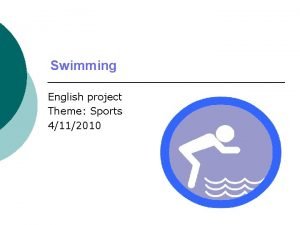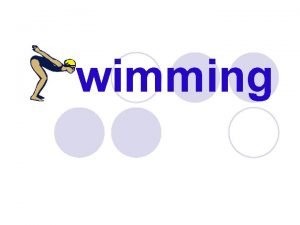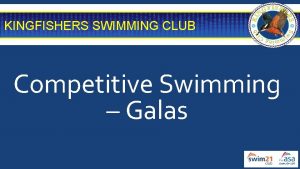Swimming English project Theme Sports 4112010 Swimming is















- Slides: 15

Swimming English project Theme: Sports 4/11/2010

Swimming is a movement through water using one’s limbs and usually without artificial apparatus. Swimming is an activity that can be both useful and recreational. “The move is an ongoing process of falling forward and a mass dropped from a higher level drops quickly, "says Bejan. “The swimmer that makes the biggest wave is the faster, and makes a long trunk and larger waves. Europeans have a 3% longer than the West African body, and this gives them 1. 5% more speed advantage in the pool, "he completes.

History Swimming has been known since prehistoric times; the earliest records of swimming date back to Stone Age paintings from around 7, 000 years ago. Written references date from 2000 BC. Some of the earliest references include the Gilgamesh, the Iliad, the Odyssey, the Bible (Ezekiel 47: 5, Acts 27: 42, Isaiah 25: 11), Beowulf, and other sagas. In 1538, Nikolaus Wynmann, a German professor of languages, wrote the first swimming book, The Swimmer or A Dialogue on the Art of Swimming. Competitive swimming in Europe started around 1800, mostly using breaststroke. In 1873 John Arthur Trudgen introduced the trudgen to Western swimming competitions, after copying the front crawl used by Native Americans. Due to a British disregard for splashing, Trudgen employed a scissor kick instead of the front crawl's flutter kick. Swimming was part of the first modern Olympic games (1896 in Athens). In 1902 Richard Cavill introduced the front crawl to the Western world. In 1908, the world swimming association, Fédération Internationale de Natation (FINA), was formed. Butterfly was developed in the 1930 s and was at first a variant of breaststroke until it was accepted as a separate style in 1952.

As occupation Some occupations require the workers to swim. For example, abalone- or pearl-divers swim and dive to obtain an economic benefit, as do spear fishermen. Swimming is used to rescue other swimmers in distress. In the USA, most cities and states have trained lifeguards, such as the Los Angeles City Lifeguards, deployed at pools and beaches. There a number of specialized swimming styles especially for rescue purposes (see List of swimming styles). Such techniques are studied by lifeguards or members of the Coast Guard. The training for these techniques has also evolved into competitions such as surf lifesaving. Swimming is also used in marine biology to observe plants and animals in their natural habitat. Other sciences use swimming, for example Konrad Lorenz swam with geese as part of his studies of animal behavior. Swimming also has military purposes. Military swimming is usually done by special forces, such as Navy SEALS. Swimming is used to approach a location, gather intelligence, sabotage or combat, and to depart a location. This may also include airborne insertion into water or exiting a submarine while it is submerged. Due to regular exposure to large bodies of water, all recruits in the United States Navy, Marine Corps, and Coast Guard are required to complete basic swimming or water survival training. Swimming is also a professional sport. Companies sponsor swimmers who are at the international level. Cash awards are also given at many of the major competitions for breaking records. Professional swimmers may also earn a living as entertainers, performing in water ballets.

Styles A style is also known as a stroke. "Stroke" can also refer to a single completion of the sequence of body movements repeated while swimming in the given style. Several swimming styles are suitable for recreational swimming; many recreational swimmers prefer a style that keeps their head out of the water and has an underwater arm recovery. Breaststroke, side stroke, head up front crawl and dog paddle are the most common strokes utilized in recreational swimming. The out-ofwater arm recovery of freestyle or butterfly gives rise to better exploitation of the difference in resistance between air and water and thus leads to higher speed. It is possible to swim by moving only legs without arms or only arms without legs. Such strokes may be used for special purposes, for training or exercise, or by amputees and paralytics.

Advantages of swimming The organization inure. Located faster and better able to adapt to environmental changes even when they are extreme, while not facing the risk of any damage to health. The functioning of the heart and circulatory affected positively. The increase in metabolism, stress and resistance of water during bathing have a significant effect on the heart and circulatory system. . . we are good! It increases the functional capacity of respiratory muscles. Swimming is directly linked to adequate and regular supply of oxygen. Good breathing technique strengthens the respiratory muscles. Combat weaknesses and faults in posture. Due to the buoyancy maintain proper posture and overall anchorage mechanism, ligaments and joints are not charged at all. Simultaneously exercise all muscles of the body heavily. It is one of the few forms of exercise while participating in almost the same percentage of all the muscles for work. Exercising in water causes euphoria and makes placing and exploding hormones responsible for the good will and euphoria of the organization.

Risks of swimming There are health risks and dangers associated with swimming. Most recorded drownings fall into one of three categories: ¡ ¡ Panic where the inexperienced swimmer or non swimmer becomes mentally overwhelmed by the circumstances of their immersion. Exhaustion, where the person is unable to sustain effort to swim or tread water. Hypothermia, where the person loses critical core temperature, leading to unconsciousness or heart failure. Less common are salt water aspiration syndrome where inhaled salt water creates foam in the lungs that restricts breathing, and hyperventilation. Around any pool area, safety equipment and supervision by personnel trained in rescue techniques is important. It is required at most competitive swimming meets, and is a zoning requirement for most residential pools in the United States.

Swimming: an individual sport Swimming is mostly an individual sport, there is no team involved in it as there is in football. Swimmers compete as individuals in competitions, and their fate relies on their own hands, not the coach, not the “team” mates but their own.

A very competitive sport The aquatic sport of swimming involves competition amongst participants to be the fastest over a given distance under self propulsion. The different events include 50, 100, and 200 yards/meters in breaststroke, freestyle, backstroke and butterfly, the '50', '100', '200', '400', '800' and '1500' free, and the '100', '200', and '400' Individual Medley, also known as the 'IM', which consists of all strokes in equal proportion, starting with butterfly then backstroke, breaststroke, and then freestyle. There also medley relays, which combine strokes swum by four relay partners leading off with Backstroke, then Breaststroke, Butterfly, and Freestyle. In this, swimmers only swim one stroke, such as 100 yards (American) or meters of butterfly, while other swimmers take the other strokes. Medley relays are swum up to 400 meters, freestyle relays up to 800 meters, with each participant swimming an equal "leg" from the racing blocks. Regulation swimming pools are either 25 or 50 meters or yards across. Racing or training from one side to the other is known as a lap (one way), so a coach may say four laps in place of 100 yards/ or 200 meters. Typical public pools, school pools, and regulation private pools tend to be 25 meters/yards long and Olympic competition is always in fifty meter pools. Swimming has been part of the modern Olympic Games sinception in 1896. Along with the other aquatic disciplines of diving synchronised swimming and water polo, the sport is governed internationally by the Fédératio Internationale de Natation (FINA), and each country has its own National Governing Body(NGB) such as United States Swimming.

Swimming at Olympics

Drugs: both popular and dangerous! For many athletes, winning is the main goal in sport. Although most of us, who relate to the sport, agree that the focus is not whether you win or lose but how you play, we know how much more fun it is to win than lose. The ultimate goal for athletes is to win either an Olympic level, or in local races. The victory is often the point of achieving a specific personal goal performance. For example, for a top athlete a new world record, for an athlete of moderate level a personal record. Most athletes train long and hard to achieve these goals and this is the most effective approach. But some of the questions that come to answer is: "How can I improve my abilities to win? ", "How can I do a new record? ". And when winning or breaking a record in sports is the only objective, some athletes use every possible means, including illegal drugs to achieve it. The use of these substances by athletes to improve their performance exists for nearly a century, but after World War II it has spread widely in athletes who took part in international and world level competitions. Today, they spread slowly in college sports as well in school sports. Doping in sport was a growing danger not taken any action until the death of a cyclist at the Olympic Games in Rome in 1960, and this triggered the creation of the Medical Committee which was affiliated to the International Olympic Committee (IOC) and legislative measures against the use of these substances at the Olympic Games.

"Doping is the application or use by an athlete of any substance foreign to the body or any natural substance used in unusual quantities or by an abnormal way for the body to increase efficiency in the race, by artificial means. ” In sport, using drugs especially during the period of intense coaching education aims to: reduce body fat increase muscle mass and strength increase red blood cells increase tolerance of the organism to coaching burden (increase in volume and intensity of your workout and quicker removal from the coaching fatigue, increase competitiveness in conditions of intense pressure during the match). Currently, the use of anabolic steroids is no longer limited only to professional athletes, but many amateurs. Amateurs usually do not use anabolic steroids to improve their performance, but for aesthetic reasons.

Steroid facts Frederic Bouske substance Eptaminolis. As revealed by Equipe, during an international meeting , he made use of the substance, which is vasodilatory, thus punished with two months of blockade. The 29 year old swimmer in an attempt to justify why the substance was found in his body, said: "I make a special treatment for a specific disease and get a medicine that does not contain any prohibited substance (usually a vasodilator used to treat the problems of low pressure ). Giannis Drimonakos On May 20 , 2008 the beta testing and sample, according to the procedure was positive for the second time for the same substance. The Hellenic Swimming Federation on May 21 announced the name of the athlete. Following this development was the Disciplinary Board. This means that if found guilty, the medals he won at the European Championships in Eindhoven (gold in the 200 m. Butterfly and silver in the 400 m. Mixed) and the World Championships in Manchester (bronze in the 400 m. Mixed) will be removed. Shortly after this development, the athlete stated in the most categorical way that had never knowingly taken or ever considered taking banned substances and announced his retirement from active swimming. On June 30, 2008, the Hellenic Swimming Federation ruled out the athlete from any event for two years.

The most popular swimmers ¡ ¡ ¡ ¡ Mark Spitz is the biggest swimmer in the history of swimming with 11 Olympic medals. Matthew Nicholas Biondi is another great swimmer in the swimming history winning 11 Olympic medals including 8 golden medals. Johnny Weissmuller is another talented swimmer in the swimming history. Ian James Thorpe is one of the most popular swimmers with 9 medals including 5 golden. Michael Fred Phelps holds 4 world records now. His best events are Freestyle and Individual medley. Kristin Otto is the famous swimmer , who won 6 golden medals at her first participation in the 1988 Olympic games. Jennifer Elisabeth Thompson is a great swimmer in world swimming. She has won 12 medals participating in 4 Olympic games.

By: Afentaki Lilian, G 4 Moragli Anna, G 4 Teacher: Ms Apostolaki
 English project about sports
English project about sports What is the theme for theme for english b
What is the theme for theme for english b Which of these sports are indoor outdoor
Which of these sports are indoor outdoor Sports in english speaking countries
Sports in english speaking countries Sports medicine team project
Sports medicine team project Theme vs genre
Theme vs genre What is the difference between theme and universal theme?
What is the difference between theme and universal theme? Universal theme definition in literature
Universal theme definition in literature Ib theme identity
Ib theme identity Theme of no speak english
Theme of no speak english Yearbook theme assignment
Yearbook theme assignment Nervous system amusement park
Nervous system amusement park Year 6 theme park project
Year 6 theme park project Year 6 theme park project
Year 6 theme park project Speak theme
Speak theme Spoken english and broken english g.b. shaw summary
Spoken english and broken english g.b. shaw summary




























